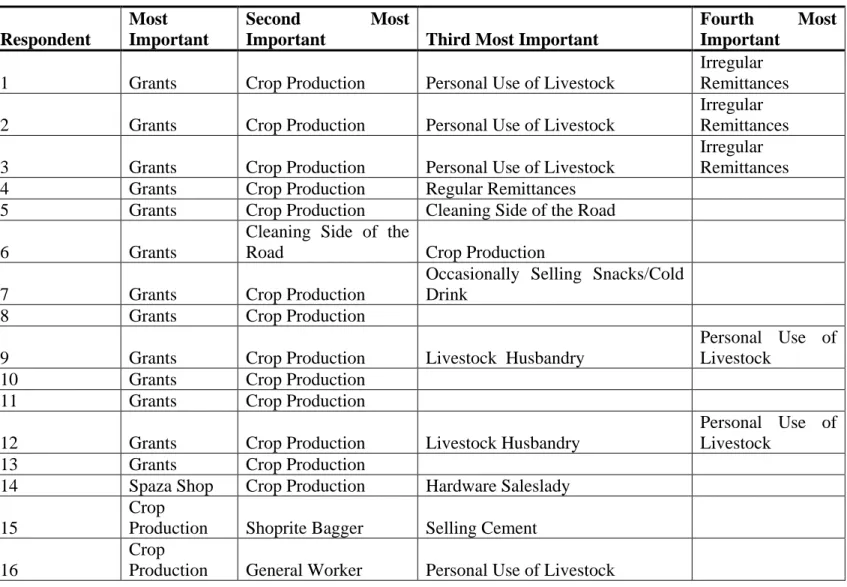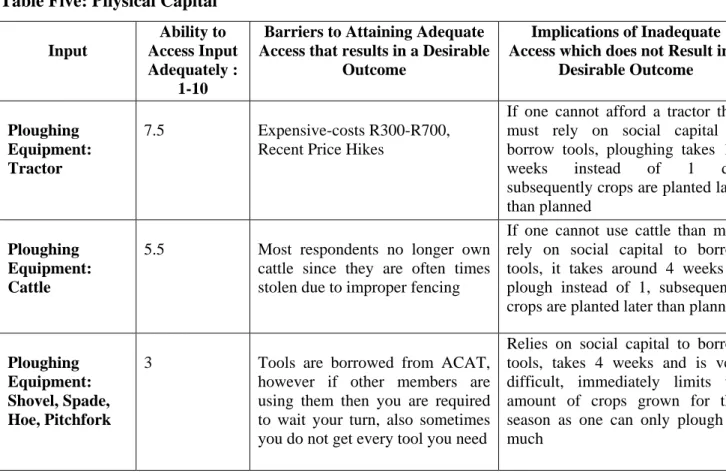While the use of agriculture as a poverty reduction strategy has been envisioned by the government as one of the key components of land reform and rural progress, its potential is limited as South African agriculture is challenged in the post-apartheid era. to provide opportunities and support for small-scale farming systems. Without her love and support I would not have been able to study in South Africa.
Introduction: The Importance of Agriculture as a Poverty Reduction Strategy in South Africa
It is in this context that the role of agriculture as a poverty alleviation strategy becomes imperative to assess, and this is the research problem that this thesis will address. This is done through both direct and indirect contributions to poverty alleviation and interventions that facilitate this, including through education and the provision of inputs, which are therefore important areas of research.
Rationale for Study: Agriculture and Land Reform in South Africa
Limitations to Land Reform: Inadequate Access to Support Services
In reality, the land reform program has yet to make a significant difference to the lives of rural South Africans. Along with input markets, the lack of infrastructure in the former homeland areas means that many small-scale farmers and land reform beneficiaries do not have access to municipal services such as water, sewage, electricity and roads (Jacobs 2003).
Accounting for the Potential of Appropriate Post-Settlement Support
This has been shown to reduce productivity for smallholder farmers in South Africa (Rother, Hall and London 2008, Andrew, Shackleton, Ainslie 2003, Fenwick and Lyne 1999). His call for a radical new food system that overcomes these weaknesses points to the necessity of the role of smallholder farmers in enabling both growers and consumers to regain control of their food system in a sustainable way (Patel 2007).
Problem Statement
The input constraints faced by smallholder farmers in municipal areas are likely to be similar to newly established smallholder farmers who benefit from land reform and do not receive post-settlement support. Therefore, I suggest that the experiences of those already farming in communal areas can be used to provide insight into the barriers to successful smallholder production, including new farmers in land reform projects.
Research Objectives
The experiences of the farmers in the case study, highlighting the need for assistance, will show that the problems facing land reform beneficiaries will go beyond access to land. Reflecting on these opportunities and barriers, I will examine whether small-scale crop production is being used to help farmers on their way out of poverty.
Defining the Small-Scale Farmer 2
Limitations of Research
At the institutional level, land reform policy recognizes gender equality, but this is not implemented as the market-led approach to land reform ignores the needs of women, favoring instead household heads and black farmers, all of whom are typically male (Walker 2002). When women do acquire land, they are disproportionately affected by the lack of post-transfer support from the patriarchal structures of their societies, and cultural taboos further hinder their ability to succeed (Agarwal 1994).
Organization of Dissertation
It gave a good sense of the efficiency of farming, as well as the past and present limitations along with what was done to overcome them. Wherever possible within the boundaries of the sample, I identify issues related to gender and small-scale farming.
Literature Review: Agriculture as a Poverty Reduction Strategy
- Introduction
- The Role of Agriculture and Poverty Reduction
- Agriculture and Pro-Poor Growth
- Agriculture and Direct Contributions towards Poverty Reduction
- Agriculture and Indirect Contributions towards Poverty Reduction
- Agricultural Production and Food Security
- Agriculture and the Importance of Land Reform as a Poverty Reduction Strategy In substantiating a case for small-scale agriculture in a country with highly unequal land
- Arguments of Efficiency
- Arguments of Equity and Pro-Poor Growth
- A Human Development Approach
- Counter-Arguing Land Reform as a Poverty Reducing Strategy
- Conclusion
Also, farmers and workers spend their growing goods and services in the local rural economy (Irz et al. 2001). Here, China's rural sector drove economic growth which reduced poverty (Ravallion and Chen 2004 cited in van den Brink et al. 2007).
Barriers to Small-Scale Farming: Institutional and Market Failures
Introduction
A Background: Why Small-Scale Farmers lack Support
- Liberalization and the Challenge of Small-Scale Farming in South Africa
- The Sustainable Livelihoods Framework: A Brief Background
- Sustainable Livelihoods Framework
- Rural Livelihoods and the Role of Agriculture
- Rural Livelihoods and the Role of Agriculture in South Africa
- Small-Scale Agricultural Production in South Africa
As suggested in the first chapter, the importance of the role of the state for small farmers also proves significant in South Africa. However, it is argued that there is a tendency to underestimate the role of agriculture and natural resource harvesting in the lives of rural households (Shackleton, Shackleton and Cousins 2000).
Limitations to Accessing Inputs
- Natural Capital Constraints: Land Policies for Secure Rights and Rental Markets Although land is the most important natural capital used by farmers, land access can be
- Financial Constraints: Accessing Credit
- Human Capital Constraints: Agricultural Extension Services and Skills Development
- Physical Constraint: Lack of Infrastructure
- Physical Constraints: Inefficient Input Markets
- Accessing Seeds
- Seed Systems
- Social Constraints: Producer Organizations
In addition to entry markets, it should also be noted that the lack of infrastructure in areas of the former homeland means that many small farmers and land reform beneficiaries do not have access to communal services such as water, sewage, electricity and roads (Jacobs 2003). . In other parts of the world, for example in Africa, this was not the case.
Conclusion
Agricultural cooperatives serving small farmers in the less developed rural areas of South Africa lack quality and stability (Ortmann and King 2007). Studies conducted on agricultural cooperatives in former homeland areas found that failure was the result of poor management, lack of training, lack of funds and conflict between members (Van der Walt 2005 cited in Ortmann and King 2007, Machethe 1990 cited in Ortmann and King 2007).
Introduction
Methodology
- The Case Study: Africa Cooperative Action Trust (ACAT )
- Area of Study: Nqutu
Of these, 55 percent are women, and about 61 percent of households are headed by women. Only 17 percent of households have access to a telephone in their homes (including mobile phones), and over 13 percent of all households have no access to a telephone at all (Stats SA 2005).
Methods of Data Collection
- Focus Groups
- Interviews
The other half of the respondents lived in an area of Nqutu called Nqopoti, which is about sixteen kilometers south of the city center. The rest of the data collection focused on in-depth semi-structured interviews with key informants and farmers.
Data Analysis
In-depth, face-to-face interviews are flexible and dynamic and allow for an understanding of interviewees' perspectives on their lives, experiences or situations as expressed in their own words (Kirk and Miller 1989). However, thanks to the translator's skills, I was able to better understand how the process should go.
Conclusion
In particular, a semi-structured interview style was chosen because "the interviewee's views are more likely to be expressed in a relatively open-ended interview situation than in a standardized interview" (Flick 1998: 76). The first interview was arranged at the ACAT headquarters with Gugu, who is the lead trainer for SAP.
Introduction
Social and Demographic Characteristics of the Respondents
- Level of Education
- Number of Household Members
- Household Survival Strategies
- Ranking of Household Strategies
- Amenities
That is more than half of the respondents with a standard education level of three or less. Fourteen of the respondents earned somewhere between €200 and €2000 last year from selling their surplus crop production.
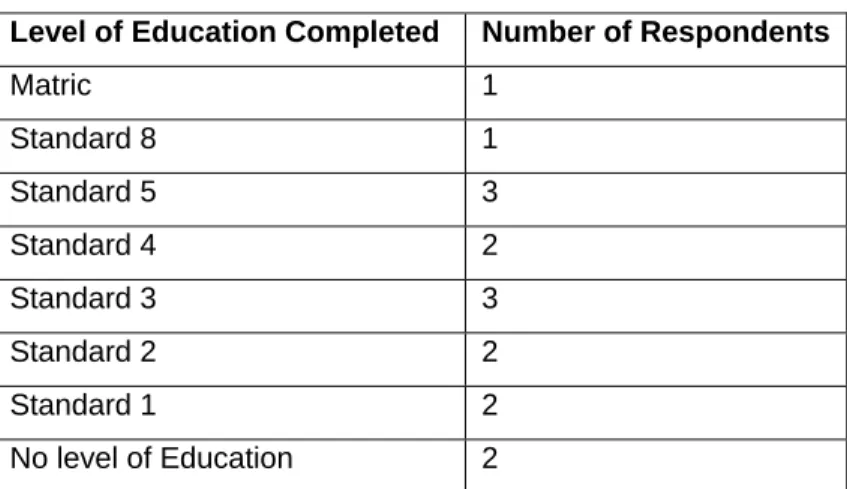
The Small-Scale Agricultural Enterprise
- Use of Land
- History of Crop Production
- Crop Production
- Livestock
- Summary of Respondent’s Background
Three of the respondents had tried growing other crops before their encounter with ACAT, but only Sipho was successful. Before successfully producing crops, most respondents only knew how to grow maize.
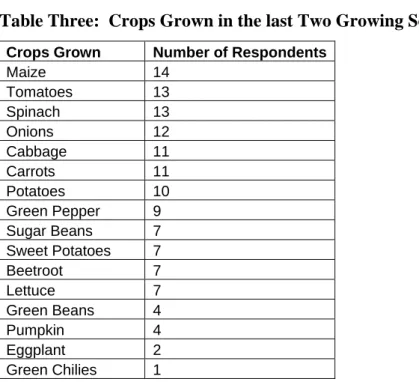
Natural Capital
- Natural Capital: Access to Water
- Natural Capital: Access to Land
While the majority of respondents had communal taps within a ten to thirty minute walk, they were unable to use them. When respondents are able to obtain larger plots of land, they have to rely on the rainy season.
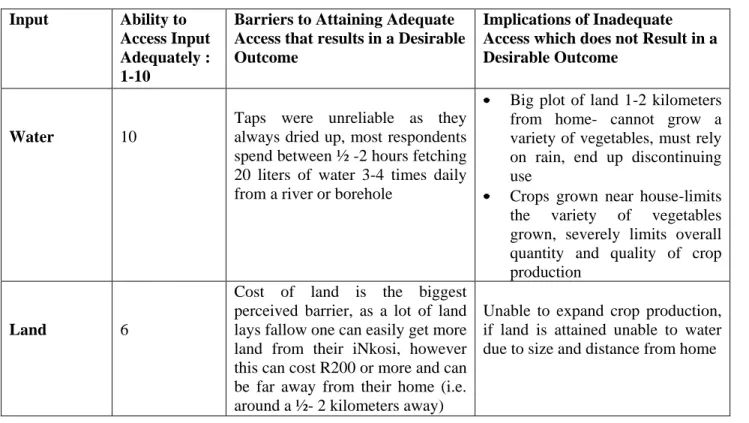
Physical Capital
- Ploughing Equipment
- Clearing and Preparing the Land
- Seeds
- Inefficiencies in the Fertilizer and Pesticide Markets: Lack of Information
- Accessing Fertilizers
- Accessing Pesticides
- Fencing
For this reason, only seven of the respondents were able to rent tractors during the 2008 growing season. Two of the respondents have not heard of any particular type of pesticide to use.
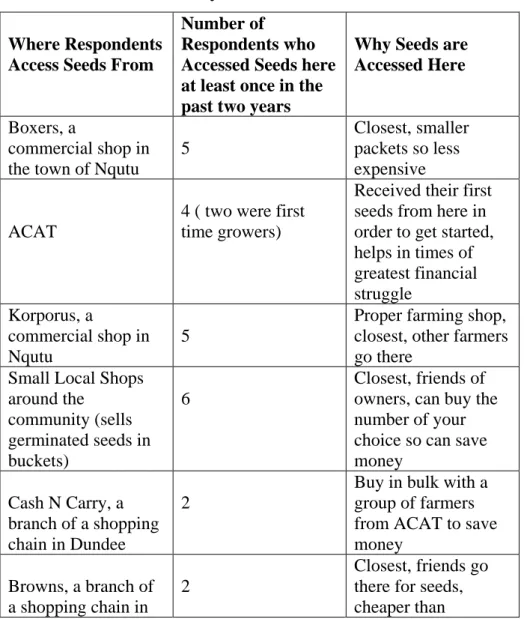
Financial Capital: Credit
However, four of these respondents mentioned the risk of not knowing how successful their harvest would be and worried that they would not be able to pay it back. However, he would love to be able to have a loan for a tractor and a proper fence.
Human and Social Capital
- Human and Social Capital: Agricultural Skills and Training
- Government
- ACAT
- Farmers in the Community
She says that for this reason the government does not understand their needs. The ultimate goal of this training is for them to be able to form successful cooperatives that receive financial assistance from the government.
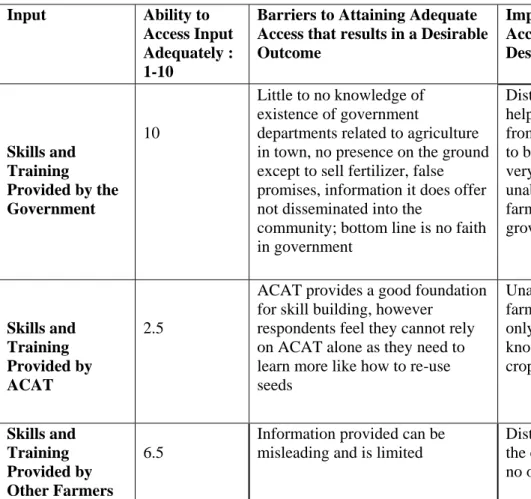
Livelihood Strategies Summary
They want to be able to grow more crops such as cucumber, cauliflower, broccoli, lentils, green beans, herbs for perfume and rice. They need to learn how to plant it, what soil to use, how much water and when to grow it.
Crop Production and the Pathway from Poverty
- Sustaining the Human Capital: Increasing Food Security and Health
- Sustaining the Financial Capital: Providing Flexibility with Budgeting
- Building Potential Social Capital: Surplus Selling, Trading, and Giveaways All of the respondents sold some of their surplus crops for income in the 2008 growing
- Towards a Pathway from Poverty
A common theme among respondents was their desire to be able to give more to the community. Also, one of the interviewees commented that she wished she had a bigger surplus so she could quit working as a road maintenance worker, as it is not well paid.
Conclusion
Every single respondent alluded to the fact that being able to grow crops had a major impact on their livelihood. Furthermore, respondents said they would like to expand their production so that they could have more profits to sell, be able to create employment in their communities and be able to give more of their profits to schools and those who have desperate need.
Summary of Thesis Rationale
Revisiting the Research Questions
- How Inputs are Obtained
- Exploring the Barriers and Opportunities to Accessing Inputs for Crop Production
- Small Scale Crop Production as a Poverty Reduction Strategy
The respondents' frustrations with an inadequate guidance service in the former home countries appeared to be consistent with findings from Jacob (2003) and Worth (2009). This is particularly worrying given the low levels of education and skills of the respondents.
Lessons at the Institutional Level
This is perhaps the most direct contribution of agriculture (Irz et al. 2001), as it has allowed respondents to consistently purchase more expensive food products such as meat and, in one case, now afford to send children to school. Small farmers can make a significant contribution to reducing poverty with a very minimal amount of support.
Recommendations for Future Research
For the land reform programme, this would mean focusing not only on the amount of land transferred, but rather on a much more nuanced qualitative point of view. Therefore, the ability of agricultural and industrial policies to reduce rural poverty should not be seen as mutually exclusive.
Final Thoughts
Developing capacity to provide effective establishment and implementation support for land and agricultural reform in South Africa. Lawrenceville, New Jersey: Africa World Press cited in Andrew, M., A. Evaluating Land and Agrarian Reform in South Africa.
ACAT
Do you think it would be more beneficial to have more access to these or would you prefer not to use any of these if possible. If the seeds were saved before harvest and reused, how many seasons is that and do you think these seeds are premium quality or are you using them out of convenience.
